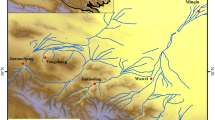Abstract
Tritium and stable isotopes contents in precipitation were analyzed on a monthly base at Hongseung which was located middle west of Korea peninsular. The precipitation of this place was influenced by China continent and Yellow Sea marine air mass environment with seasonal variation. Precipitation was sampled from March 2018 to August 2020. The 3H concentration was high at spring and low at summer and ranged from 1.54 to 10.76 TU. The stable isotopes concentration such as δ18O ranged from − 13.24 to − 2.64‰ and δD ranged from − 95.23 to − 11.72‰ with seasonal variation.





Similar content being viewed by others
References
Solomon DK, Cook PG (2000) In: Cook PG, ALed Herezeg (eds) Environmental tracers in subsurface hydrology. Kluwer Academic demic Publishers, Boston
Rooyen JD, Palcsu L, Visser A, Vennemann TW, Miller JA (2021) Spatial and temporal variability of tritium in precipitation within South Africa and it’s bearing on hydrological studies. J Environ Radioact 226:106354
Fórizs I, Kerna Z, Csicsák J, Csurgó G, Földing G, Máthé Z, Ország J, Szreda G, Vendégh R (2020) Monthly data of stable isotopic composition (δ18O, δ2H) and tritium activity in precipitation from 2004 to 2017 in the Mecsek Hills, Hungary. Data Brief 32:106206
László E, Palcsu L, Leelössy Á (2020) Estimation of the solar-induced natural variability of the tritium concentration of precipitation in the Northern and Southern Hemisphere. Atmos Environ 233:117605
Chae J, Kim G (2019) Seasonal and spatial variations of tritium in precipitation in Northeast Asia (Korea) over the last 20 years. J Hydrol 574:794–800
Tadros CV, Hughes CE, Crawford J, Hollins SE, Chisari R (2014) Tritium in Australian precipitation: a 50 year record. J Hydrol 513:262–273
Craig H (1961) Isotopic variationin meteoricwaters. Science 133(3465):1702–1703
Dansgaard W, Johnsen SJ, Clausen HB (1993) Evidence for general instability of past climate from a 250-kyr ice-core record. Nature 364:218–220
Dansgaard W (1964) Stable isotopes in precipitation. Tellus 16:436–468
Karlovic I, Tamara Markovic T (2020) Data on stable isotopic composition of δ18O and δ2H in precipitation in the Varaždin area, NW Croatia. Data Brief 33:106573
Sonia Valdivielso S, Vazquez-Sune E, Custodio E (2020) Origin and variability of oxygen and hydrogen isotopic composition of precipitation in the Central Andes: a review. J Hydrol 587:124899
IAEA GNIP data. https://nucleus.iaea.org/wiser/index.aspx
Feng X, Faiia AM, Posmentier ES (2009) Seasonality of isotopes in precipitation: a global perspective. J Geophy Res 114:D08116
Amundson R, Chawick O, Kendall C, Wang Y, DeNiro M (1996) Isotopic evidence for shifts in atmospheric circulation patterns during the late quaternary in mid-North America. Geology 24(1):23–26
Rozanski K, Sonntag C, Münnich KO (1982) Tellus 34:142–150
KMA (2012) The climate atlas of Korea. Korea Meteorological Administration
Yoon YY, Kim KJ, Lee KY, Ko KS (2010) Tritium concentration in rain with seasonal variation. Anal Sci Tech 23(2):161–164
Ha K, Yoon YY, Lee KY, Cho SY, Ko KS (2013) Seasonal variation in the isotopic contents of precipitation in Korea. J Radioanal Nucl Chem 296:389–395
Bolin B (1958) On the use of tritium as a tracer for water in nature. In: Proceedings of the Second United Nations conference on the peaceful uses of atomic energy, pp 336–343
Visser A, Thaw M, Esser B (2018) Analysis of air mass trajectories to explain observed variability of tritium in precipitation at the Southern Sierra Critical Zone Observatory, California, USA. J Environ Radioact 181:42–51
Dansgaard W (1964) Tellus 16(4):437–468
Lee KS, Chung JI (1997) Ecom Environ Geol 30:321–325
Acknowledgements
This work was supported by the Basic Research Project (20-3411) of the Korea Institute of Geoscience and Mineral Resources (KIGAM), funded by the Ministry of Science and Information and Communications Technology.
Author information
Authors and Affiliations
Corresponding author
Additional information
Publisher’s Note
Springer Nature remains neutral with regard to jurisdictional claims in published maps and institutional affiliations.
Rights and permissions
About this article
Cite this article
Yoon, Y.Y., Koh, D.C. Tritium and stable isotope content variation in precipitation at Hongseung: West Korea Region. J Radioanal Nucl Chem 330, 413–417 (2021). https://doi.org/10.1007/s10967-021-07955-x
Received:
Accepted:
Published:
Issue Date:
DOI: https://doi.org/10.1007/s10967-021-07955-x




